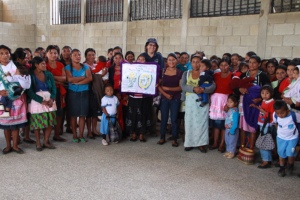The Impact of COVID-19 on Poverty in Guatemala

Despite the poverty rate in Guatemala rising from 45.6% to 47% in 2020, social protection programs have prevented a calamity as the implications of COVID-19 hit vulnerable households. UNICEF initiated financial and social programs to support households in Guatemala to ease the impact of COVID-19 on poverty in Guatemala.
Impact of COVID-19 on Poverty in Guatemala
The COVID- 19 pandemic devastated Guatemala as one of the most impoverished countries in Central America. The state suffered numerous losses as its already poor health system faces challenges in keeping up with the pandemic events. According to Alonzo et al. (2021), the pandemic complicated pre-pandemic stressors given that Guatemala is known for high rates of chronic malnutrition, poverty and inequality.
Poverty Rate in Guatemala
With increasing population rates, Guatemala is a country faced with crises that require humanitarian interventions. According to the World Bank, Guatemala’s poverty rate of 52.4% in 2020 has created vulnerabilities that harshly affect children. Chronic child malnutrition impacts 47% of children younger than 5 and 58% of Indigenous Guatemalan children.
Additionally, Hurricanes Eta and Iota led to devastation for numerous households, increasing the catastrophic implications of COVID-19 in November 2020. The IFRC reported that “at least 1.5 million people were displaced in Central America as a consequence of disasters, including Hurricanes Eta and Iota: 937,000 in Honduras, 339,000 in Guatemala and 232,000 in Nicaragua.” Such projections paint the true situation in Guatemala as poverty ravages the population.
Government Responses in Guatemala
Since 2018, Guatemala has introduced social and financial programs targeting poverty alleviation. The nation allocated 1.3% of its GDP to fund projects like Bono Social, the national cash transfer program, and Bono Familia, an emergency cash assistance program to support families during COVID-19.
According to Cejudo et al. (2020), Bono Familia provides a “temporal supplementary monthly income of $130 to vulnerable families with a monthly electricity consumption below 200 kWh (based on their electricity bill).” Combined with Bono Social, the national cash transfer scheme, the government supported vulnerable families, ensuring they received financial aid to boost their economic situation.
Other programs include Fondo de Protección al Empleo and Bono al Comercio Popular. The former establishes a temporary daily income for formal workers who lost their jobs during the pandemic. The latter targeted informal traders. However, the public criticized these government interventions due to poor execution. Additionally, the bureaucratic nature of the fund distribution made it difficult for the targeted families to receive financial assistance.
Role of UNICEF in Mitigating COVID-19’s Impact
The Ministry of Social Development (MIDES) and UNICEF have been working together to improve the administrative and managerial processes that support Guatemala’s interventions for poverty that the COVID-19 pandemic caused. With the support of the World Bank, UNICEF introduced initiatives to support Guatemala’s social protection frameworks. By launching an effective Management Information System (MIS), UNICEF initiated strategies to enhance children’s access to education and health services. As part of the Bono Social initiative, the goal was to fulfill the potential of young boys and girls through education.
Within three months of Bono Familia’s implementation, UNICEF and World Bank helped more than 2.6 million people across 340 municipalities in Guatemala through emergency cash transfers. Therefore, as families lost income through employment loss, the program boosted their financial support to protect vulnerable households.
Accessing Vulnerable Households
UNICEF faced difficulties reaching vulnerable households, especially since the organization lacked data on the social demographic of Guatemalans. To overcome this, the humanitarian organization introduced an innovative platform that enabled a social registry. Consequently, this ensured the Guatemalan government could enhance its cash transfer policies to meet the objectives of its social programs. Therefore, Guatemalans received cash injections that allowed payment in pharmacies, stores and gas stations.
Through technological solutions, UNICEF learned more about responding to Guatemala’s poverty. According to its report, most of the younger population supported the older generation, ensuring they received access to social programs. Additionally, the integrated platform has undergone establishment on a national grid, allowing better approaches for implementing future programs.
Eradicating Poverty in Guatemala
As Guatemala enhances its social protection programs to ensure every household can access them, eradicating poverty must follow strategic responses aligned to its economic and political framework. According to UNICEF, legal and political ideologies should support the vision of social protection programs, mainly targeting vulnerable households. The COVID-19 pandemic exacerbated the challenge of poverty in Guatemala and responses must focus on addressing gaps in technology and information to better access vulnerable families.
Most importantly, engaging with humanitarian groups to increase contact points in social protection programs has enhanced the capabilities of the Guatemalan government in mitigating poverty. As more community stakeholders involve themselves in the implementation stages at local and national levels, organizational capacities to reduce poverty in Guatemala are more effective. With UNICEF offering support to “develop a consolidated social protection system which includes strengthening all child-focused social protection programs, enhancing access to services as well as early childhood programs and augmenting humanitarian support,” stakeholders can effectively mitigate the impact of COVID-19 on poverty in Guatemala.
– Hanying Wang
Photo: Flickr
